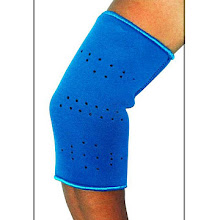Let's talk about medical advances.
One of the risks of total knee replacement surgery is deep vein thrombosis ("DVT") afterwards, in which a blood clot forms in the calf and then migrates to the lungs or the heart or the brain - there's no real good place to have one.
To prevent this event patients are routinely given anticoagulants after surgery. I take it that these medications thin the blood, make it less likely to clot and therefore less likely to form a DVT. I have no idea how they work.
Lovenox is such a drug, and is taken by self-administered injection. They showed me how to do this in the hospital. All the muss and fuss have been taken out of this procedure. One is given an already-loaded syringe with a thin needle about an inch long. After swabbing abdominal skin with alcohol (they give you the swabs too, in little packets) you pinch up some skin and just jab the thing straight in. (No, surprisingly, it doesn't hurt.) Push the plunger all the way in, pull the thing out, push a little lever which shoots a plastic protector around the needle, drop the whole thing in a sharps disposal container. Once a day for ten days after coming home.
The list price is $200 per shot, for a total of $2,000 for a course of treatment. This is clearly off the wall, and Blue Cross of course has no time for this nonsense. There is, however, a $200 co-pay, again for the whole ten days.
So I called the doctor to ask if this trip is really necessary, and he said that there are lots of anticoagulants, notably coumadin aka warfarin aka rat poison. This stuff has been around since the early part of the last century, and is cheap as dirt.
So why are we using this pricey stuff? Because getting the dosage right for coumadin is a hassle. It requires several blood tests, and that they fiddle with it a lot. He got two sentences into the explanation and already we'd used up $200 of my attention. I have no idea whether the drug itself in Lovenox is better at its job than coumadin, but I can tell you that the dosage and delivery systems are far superior. The last thing I wanted to do at that point was tour all over the landscape having blood drawn.
So, if I were Empress for a Year and running the newly fixed American health care system, would I opt for coumadin or Lovenox in this situation? In the coumadin scenario, remember, although the drug iself is cheap, that's not the end of the story, it takes up the time of professionals to draw the blood and fiddle with the dosage, and that costs money too, of course. Would I require patients like myself to pay extra for convenience, or would I just say, "The heck with it, give everyone the little syringes and move on"?
As we dig a little deeper here, why is Lovenox so expensive? Is it made of ground up grass seeds from an itty-bitty grass that grows only in Siberia or something? Of course not. It's expensive because the drug company that holds the patent is sticking us up (or, legitimately trying to recover development costs, your choice) in preparation for the day when Lovenox goes out of patent and can be manufactured in generic, at which point the price will drop.
Does this make the drug company a bad guy? Not necessarily. Whoever they are, they had to do a lot of development and testing on this stuff, along with a lot of other stray ideas that didn't come to anything. They put this money in because they hoped to make a profit if Lovenox panned out. If we expect them to continue to do all this R&D we have to reward them with some profits when things work.
In the big picture, Lovenox is an improvement. Effective and easy of dosage, no muss no fuss. I don't much like sticking myself with needles, but I'm getting over it. Is it essential? Probably not, we could lump along with warfarin perfectly well, but isn't improvement in care desirable? I think so.
I don't know the answers to any of the questions I've proposed. And if you'll excuse me now, I have to go stick myself with a needle.
Subscribe to:
Post Comments (Atom)

There's more to the Lovenox story, which I found when Aliza was told she had to use it to ward off DVT in herself for the duration of her pregnancy and 8 weeks after. secondarily, it's improve the odds of the baby surviving.
ReplyDeletethere is actually some problem with the patent as it turns out, according to some website I found (don't ask me now, it was a while ago), but for some other pharmacological reason, it has not been possible for anyone else to make a viable generic.
However, given that I have seen it advertised for quite a bit less than $200 a shot, and one man (bewailing his insurance company's flat-out refusal to cover it for his wife) had even found a 90-day supply at Rite-aid, for what comes in at something like $25 a shot, if my memory serves me correctly,it is quite likely that there is in fact absolutely no need for that ridiculous price.
I have no idea what MassHealth is paying for it for Aliza. I am only glad that they are.
I'm glad Aliza is getting good care too.
ReplyDeleteMy question is, what does Lovenox do that coumadin doesn't? Is the new "improved" drug really better, or is it just more profitable for the drug company?
I'd be interested in seeing some studies on this. Anti-coagulants (which is what we're talking about here) aren't really all that complicated or high-tech.